Wildflowers of the Adirondacks:
Shinleaf (Pyrola elliptica Nutt.)
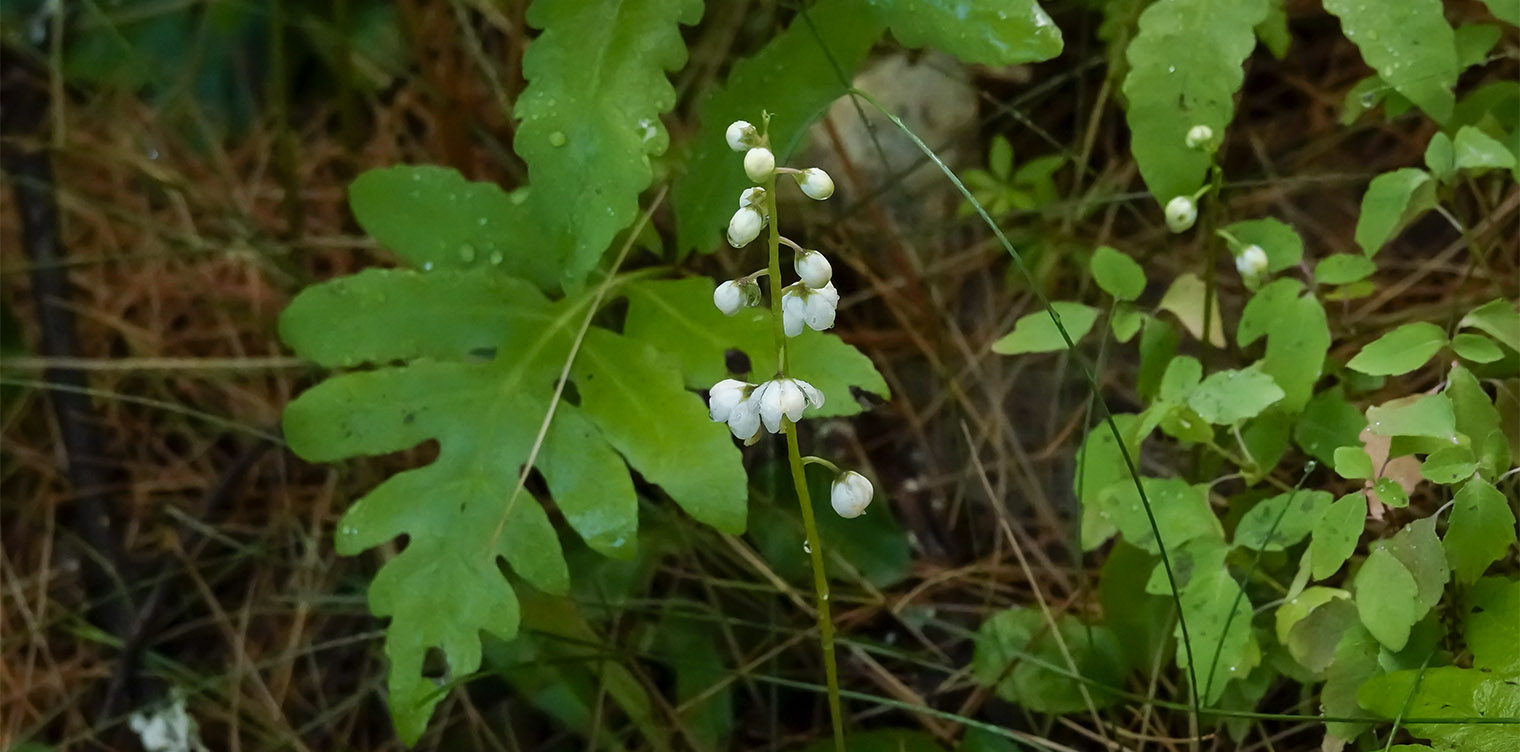
Shinleaf (Pyrola elliptica Nutt.) is a native Adirondack wildflower which produces waxy white flowers in early summer in the Adirondacks of upstate New York. It is classified as a shrub or subshrub. At one time, these and related plants were classified as a separate family (Pyrolaceae), but more recent genetic research has reclassified Shinleaf and other pyrolas into the family Ericaceae.
Shinleaf is the most common species of pyrola. This plant is one of five pyrolas that occur in the Adirondack area. The others are: Round-leaved Shinleaf (Pyrola americana), Pink Shinleaf (Pyrola asarifolia ssp. Asarifolia), Green-flowered Shinleaf (Pyrola chlorantha), and Lesser Shinleaf (Pyrola minor).
The genus name (pyrola) is a diminutive form of Pyrus (pear) – purportedly a reference to the shape of the leaf. The species name (elliptica) refers to the elliptical shape of the leaves. The scientific name includes a reference to Thomas Nuttall, an English botanist and zoologist who published Genera of North American Plants in 1818. He later developed an interest in ornithology and published his Manual of the Ornithology of the United States and of Canada in the 1830s. Shinleaf is listed in some sources as Pyrola compacta.
The common name (Shinleaf) opposis a reference to the medicinal properties of the plant. The leaves are said to have analgesic properties and were used as a poultice on bruised shins and other sores and wounds. Such a leaf plaster was referred to as a shin plaster. Other common names include Waxflower Shinleaf, Wax-flower Wintergreen, Elliptic-leaved Shinleaf, Large-leaved Shinleaf, and Common Shinleaf.
Identification of Shinleaf
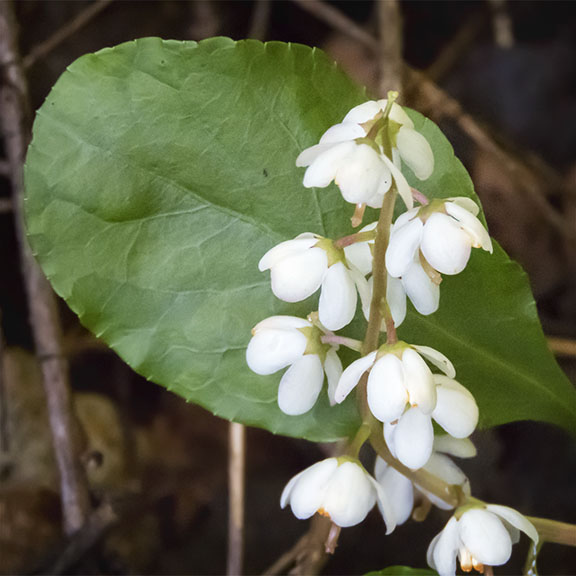
Shinleaf is an erect perennial, about four or five to ten or twelve inches tall.
- The leaves are green and one to 2 ¾ inches long.
- The leaves grow in a rosette, usually at ground level.
- The leaves have very small teeth.
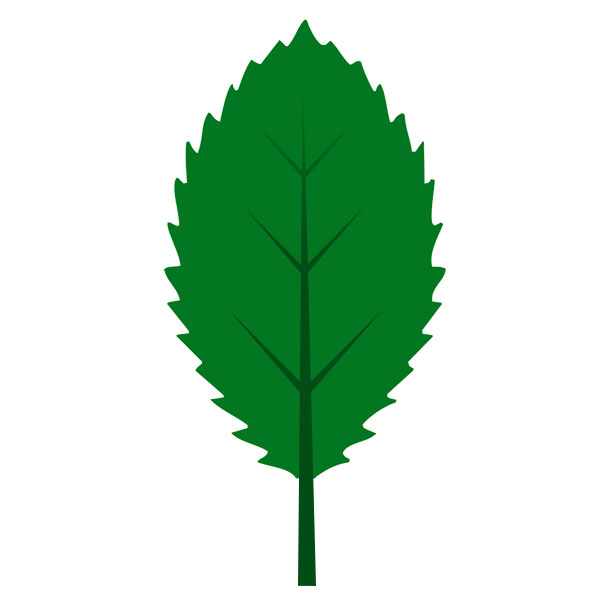 Toothed leaves have a saw-toothed edge.
Toothed leaves have a saw-toothed edge. - The leaf stalk is generally as long as or slightly shorter than the leaf blade.
.jpg) The flat portion of a leaf, petal, or sepal.
The flat portion of a leaf, petal, or sepal. - The leaf shape is oblong (elliptical). This distinguishes the Shinleaf from a similar plant that grows in our area – the Round-leaved Pyrola (Pyrola americana). The Round-leaved Pyrola has roundish leaves and somewhat shorter leaf stalks.
The fragrant, nodding flowers bloom on unbranched stalks. The stalks vary in height, from about four inches in some cases to up to about 10 inches in height.
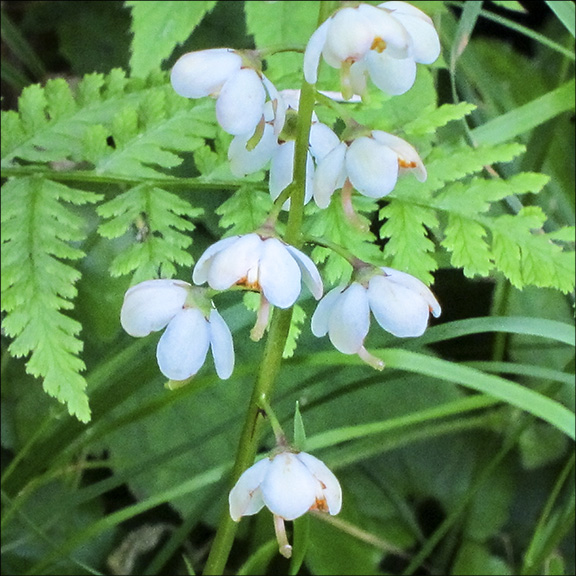
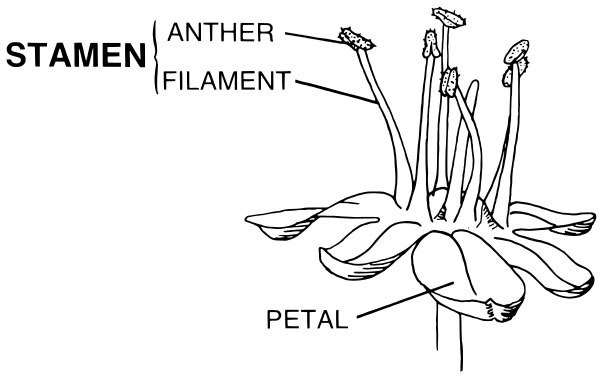 The male part of the flower, made up of the filament and anther.
The male part of the flower, made up of the filament and anther.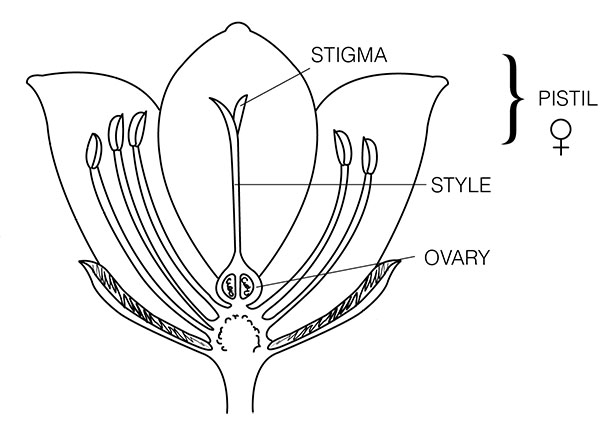 The narrow part of the pistil.
The narrow part of the pistil.
- Each stalk has three to 21 greenish-white, waxy flowers. The long flower stalk is hairless.
The flowers are alternateand appear along the upper part of the stem.
.jpg) Appearing singly along the stems, not in pairs.
Appearing singly along the stems, not in pairs. - In contrast to One-sided Wintergreen (Orthilia secunda), another member of the Ericaceae family, Shinleaf flowers are not one-sided; they appear around all sides of the flower stem.
- Each flower is about ⅓ inch wide. Shinleaf flowers have five oval petals and a cluster of orange-tipped stamensunder the upper petals. The flowers also have a long curved, pale green
 The male part of the flower, made up of the filament and anther.style, which is the long, tube-like part of the
The male part of the flower, made up of the filament and anther.style, which is the long, tube-like part of the The narrow part of the pistil.
pistil. The petals may have greenish veins. The
The narrow part of the pistil.
pistil. The petals may have greenish veins. The The female part of the flower made up of the stigma, style, and ovary.
sepalsare triangular, about as long as wide and about ¼ as long as the petals.
The female part of the flower made up of the stigma, style, and ovary.
sepalsare triangular, about as long as wide and about ¼ as long as the petals..gif) The parts that look like little green leaves and cover the outside of a flower bud to protect the flower before it opens.
The parts that look like little green leaves and cover the outside of a flower bud to protect the flower before it opens.
Shinleaf usually begins blooming in late June or early July in the Trilakes area of the Adirondacks. A tally of flowering dates for the upland Adirondack areas compiled by Michael Kudish, based on data collected from the early seventies to the early nineties, lists the flowering dates for Shinleaf as 7 through 28 July, with a median flower date of 18 July.
The flowers are followed by fruit, which is a flattened, round, five-chambered capsule about ¼ inch in diameter. Attached to the bottom is the remains of the style. In the Adirondacks, Shinleaf fruit appears around the first week of September.
Uses of Shinleaf
No edible uses were found for Shinleaf.
The Shinleaf does appear to have some medicinal uses. The leaves are said to contain an aspirin-like substance and have been used on bruises and wounds to reduce pain. Native Americans used the plant to treat several ailments. The Cherokee, for instance, used it as a dermatological aid for cuts and sores. The Iroquois reportedly gave babies a decoction of roots and leaves to relieve fits or epileptic seizures. They also used a compound infusion of plants for rheumatism. The Mohegans are said to have used an infusion of leaves as a gargle for sores or cankers in the mouth.
Wildlife Value of Shinleaf
Shinleaf has negligible value as a source of food or cover for wildlife. It is not a favorite browse for White-tailed Deer. Shinleaf plants, along with other pyrolas, are reportedly eaten in minimal amounts by Ruffed Grouse in some areas, but constitute only ½ to 2% of their diet.
Distribution of Shinleaf
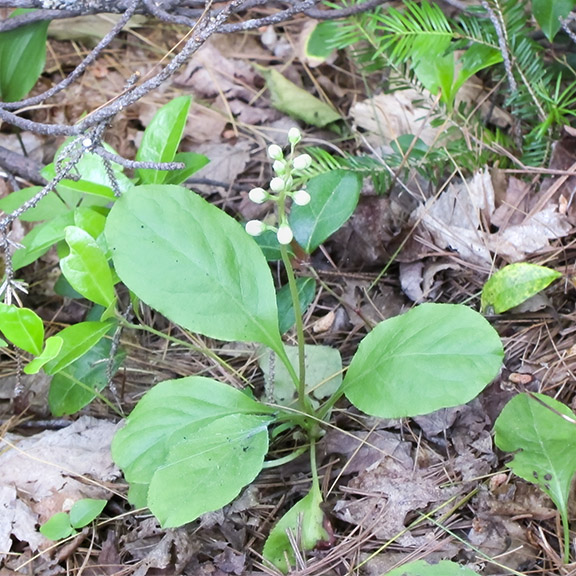
Shinleaf is widely distributed on the North American continent. The plant is found across most of the northern half of the US, south to West Virginia. It is also found in the southern provinces of Canada.
In New York State, Shinleaf occurs in most counties and in all of the counties within the Adirondack Blue Line.
Habitat of Shinleaf
In terms of site and soil requirements, Shinleaf is relatively versatile. It apparently prefers dappled shade or a shady edge, but can grow in shadier sites on well-drained soils.
Its habitat requirements are also rather flexible, growing in several different kinds of forests, including sandy or loamy woods and on shaded stream banks, especially under hardwoods. It usually occurs in non-wetlands, but has been seen occasionally in wetlands.
In the Adirondack region, Shinleaf can be found in both hardwood and mixed wood forests, under both hardwoods and conifers. It grows along many of the trails featured here. In the Lake Placid area, for instance, you can find Shinleaf along the Peninsula Nature Trails and the Potato Loop Trail at John Brown Farm.
- Look for it blooming in shade under Balsam Fir and Hobblebush, near low-growing Dewdrops, which are also blooming around this time.
- Not too far away look for the orange flowers of another summer bloomer: Spotted Touch-Me-Not.
- Nearby Clintonias, which bloom in late spring, will have stopped blooming by this time, but are already sporting their deep blue berries. Jack-in-the-Pulpit, another late-spring blooming wildflower, will also have gone to fruit, displaying a cone of shiny green berries which will later turn a vibrant red.
References
Michael Kudish. Adirondack Upland Flora: An Ecological Perspective (The Chauncy Press, 1992), pp. 25-28, 146-147.
New York Flora Association. New York Flora Atlas. Common Shinleaf. Pyrola elliptica Nutt. Retrieved 17 November 2017.
Integrated Taxonomic Information System. Pyrola elliptica Nutt. Retrieved 19 November 2017.
United States Department of Agriculture. The Plants Database. Waxflower Shinleaf. Pyrola elliptica Nutt. Retrieved 17 November 2017.
Flora of North America. Pyrola elliptica Nuttall. Retrieved 17 November 2017.
Native Plant Trust. Go Botany. Elliptic-leaved Shinleaf. Pyrola elliptica Nutt. Retrieved 23 June 2021.
New York State. Adirondack Park Agency. Preliminary List of Species Native Within the Adirondack Park Listed Alphabetically by Scientific Name and Sorted by Habit. Volume 1. Updated 10.23.2006, p. 33. Retrieved 26 January 2017.
Connecticut Botanical Society. Shinleaf. Pyrola elliptica Nutt. Retrieved 17 November 2017.
University of Wisconsin. Flora of Wisconsin. Pyrola elliptica Nutt. Retrieved 17 November 2017.
Minnesota Wildflowers. Shinleaf. Pyrola elliptica. Retrieved 17 November 2017.
Lady Bird Johnson Wildflower Center. Pyrola elliptica. Retrieved 17 November 2017.
Online Encyclopedia of Life. Waxflower Shinleaf. Pyrola elliptica. Retrieved 17 November 2017.
New York State Department of Environmental Conservation. Winter Deer Foods. Retrieved 18 November 2017.
iNaturalist. Shinleaf. Pyrola elliptica. Retrieved 23 June 2021.
iNaturalist. Adirondack Park Observations. Shinleaf. Pyrola elliptica. Retrieved 23 June 2021.
Anne McGrath. Wildflowers of the Adirondacks (EarthWords, 2000), p. 17.
Roger Tory Peterson and Margaret McKenny. A Field Guide to Wildflowers. Northeastern and North-central North America (Houghton Mifflin Company, 1968), pp. 26-27.
Doug Ladd. North Woods Wildflowers (Falcon Publishing, 2001), p. 211.
Lawrence Newcomb. Newcomb's Wildflower Guide (Little Brown and Company, 1977), pp. 178-179.
David M. Brandenburg. Field Guide to Wildflowers of North America (Sterling Publishing Company, Inc., 2010), p. 452.
John Kricher. A Field Guide to Eastern Forests. North America (Houghton Mifflin, 1998), p. 62.
Timothy Coffey. The History and Folklore of North American Wildflowers (FactsOnFile, 1993), pp. 98-99.
Ruth Schottman. Trailside Notes. A Naturalist's Companion to Adirondack Plants (Adirondack Mountain Club, 1998), p. 81.
National Audubon Society. Field Guide to North American Wildflowers. Eastern Region. (Alfred A. Knopf, 2001), pp. 718-719, Plate 122.
Gary Wade et al. Vascular Plant Species of the Forest Ecology Research and Demonstration Area, Paul Smiths, New York. USDA Forest Service. Research Note NE-380, p. 4. Retrieved 22 January 2017.
Mark J. Twery, at al. Changes in Abundance of Vascular Plants under Varying Silvicultural Systems at the Forest Ecosystem Research and Demonstration Area, Paul Smiths, New York. USDA Forest Service. Research Note NRS-169, p. 8. Retrieved 22 January 2017.
Alexander C. Martin, Herbert S. Zim, and Arnold L. Nelson. American Wildlife & Plants. A Guide to Wildlife Food Habits (Dover Publications, 1951), p. 95.
Plants for a Future. Pyrola elliptica - Nutt. Retrieved 17 November 2017.
Steven Foster and James A. Duke. Medicinal Plants and Herbs of Eastern and Central North America (Houghton Mifflin Harcourt, 2014), p. 50.
University of Michigan. Native American Ethnobotany. A Database of Foods, Drugs, Dyes and Fibers of Native American Peoples, Derived from Plants. Waxflower Shinleaf. Pyrola elliptica Nutt. Retrieved 17 November 2017.
Allen J. Coombes. Dictionary of Plant Names (Timber Press, 1994), p. 154.
Charles H. Peck. Plants of North Elba. (Bulletin of the New York State Museum, Volume 6, Number 28, June 1899), p. 114. Retrieved 22 February 2017.
Thomas Nuttall. The genera of North American plants: and a catalogue of the species, to the year 1817 (D. Heartt, 1818), Volume 1, pp. 272-273. Retrieved 18 November 2017.
John Nelson, "Thomas Nuttall: Brief life of a pioneering naturalist: 1786-1859," Harvard Magazine, May-June 2015. Retrieved 18 November 2017.
Wildflowers of the Adirondack Park
